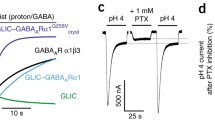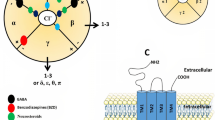Abstract
Analogues of the neurotransmitter GABA containing unsaturated bonds are restricted in the conformations they can attain. This review traces three such analogues from their synthesis to their use as neurochemicals. trans-4-Aminocrotonic acid was the first conformationally restricted analogue to be extensively studied. It acts like GABA across a range of macromolecules from receptors to transporters. It acts similarly to GABA on ionotropic receptors. cis-4-Aminocrotonic acid selectively activates bicuculline-insensitive GABAC receptors. 4-Aminotetrolic acid, containing a triple bond, activates bicuculline-sensitive GABAA receptors. These findings indicate that GABA activates GABAA receptors in extended conformations and GABAC receptors in folded conformations. These and related analogues are important for the molecular modelling of ionotropic GABA receptors and to the development of new agents acting selectively on these receptors.





Similar content being viewed by others
References
Musashi A (1954) The synthesis of γ-aminocrotonic acid and γ-aminobutyric acid. Hoppe-Seyler’s Z Physiol Chem 297:71–73
Tomita KI (1971) Crystal data and some structural features of γ-aminobutyric acid, 3-aminopropane sulfonic acid and their derivatives. Tetrahedron Lett 12:2587–2588
Jones GP, Pauling PJ (1975) Crystal and molecular structure of trans-4-aminocrotonic acid. J Chem Soc Perkin Trans 2:1059–1062
King EJ (1954) The thermodynamics of ionization of amino acids.1. The ionization constants of gamma-aminobutyric acid. J Am Chem Soc 76:1006–1008
Beart PM, Johnston GAR, Uhr ML (1972) Competitive inhibition of GABA uptake in rat brain slices by some GABA analogues of restricted conformation. J Neurochem 19:1855–1861
Purpura DP (1960) Pharmacological actions of ω-amino acid drugs on different cortical synaptic organizations. In: Inhibition nervous system gamma-Amino-butyric Acid, Proc Intern Symp, Duarte, Calif vol 1959, pp. 495–514
Krnjevic K, Phillis JW (1963) Iontophoretic studies of neurons in the mammalian cerebral cortex. J Physiol 165:274–304
Johnston GAR, Curtis DR, Beart PM, Game CJA, McCulloch RM, Twitchin B (1975) cis- and trans-4-Aminocrotonic acid as GABA analogues of restricted conformation. J Neurochem 24:157–160
Falch E, Hedegaard A, Nielsen L, Jensen BR, Hjeds H, Krogsgaard-Larsen P (1986) Comparative stereostructure-activity studies on GABA-A and GABA-B receptor-sites and GABA uptake using rat-brain membrane preparations. J Neurochem 47:898–903
Beart PM, Johnston GAR (1973) Transamination of analogues of γ-aminobutyric acid by extracts of rat brain mitochondria. Brain Res 49:459–462
Borowicz KK, Zadrozniak M, Czuczwar SJ (2005) GABAA and GABAC receptors, shows a proconvulsant action in the electroconvulsive threshold test in mice. Pharmacol Rep PR 57:121–123
Chebib M, Vandenberg RJ, Johnston GAR (1997) Analogues of γ-aminobutyric acid (GABA) and trans-4-aminocrotonic acid (TACA) substituted in the 2 position as GABAC receptor antagonists. Br J Pharmacol 122:1551–1560
Beart PM, Curtis DR, Johnston GAR (1971) 4-Aminotetrolic acid: new conformational-restricted analogue of γ-aminobutyric acid. Nature 234:80–81
Beart PM, Johnston GAR (1972) Acetylenic analogues of γ-aminobutyric acid. Aust J Chem 25:1359–1361
Jones GP, Pauling PJ (1976) Crystal and molecular structure of 4-aminotetrolic acid (4-amino-but-2-ynoic acid). J Chem Soc Perkin Trans 2:32–33
Warner D, Borthwick PW, Stewart EG (1975) Complete neglect of differential overlap/2 molecular orbital studies on the electronic structure and conformational modes of 4-aminotetrolic acid. J Mol Struct 25:397–402
Allan RD, Johnston GAR (1985) Synthesis of analogues of GABA. XIII An alternative route to (Z)-4-aminocrotonic acid. Aust J Chem 38:1647–1650
Duke RK, Allan RD, Drew CA, Johnston GAR, Mewett KN, Long MA, Than C (1993) The preparation of tritiated E-4-aminobut-2-enoic and Z-4-aminobut-2-enoic acids, conformationally restricted analogues of the inhibitory neurotransmitter 4-aminobutanoic acid (GABA). J Label Compd Radiopharm 33:527–540
Ahern DG, Laseter AG, Filer CN (2003) The synthesis and characterization of [2,3-3H] γ-aminobutyric acid via 4-aminotetrolic acid at high specific activity. Appl Radiat Isot 58:477–479
Filer CN (2010) GABAergic radioligands labelled with tritium. J Label Compd Radiopharm 53:120–129
Ahern DG, Laseter AG, Filer CN (2002) An improved synthesis of 4-aminotetrolic acid. Synth Commun 32:665–667
Bowery NG, Jones GP (1976) A comparison of γ-aminobutyric acid and the semi-rigid analogues 4-aminotetrolic acid, 4-aminocrotonic acid and imidazole-4-acetic acid on the isolated superior cervical ganglion of the rat. Br J Pharmacol 56:323–330
Beart PM, Johnston GAR (1972) Bicuculline and GABA-metabolising enzymes. Brain Res 38:226–227
Johnston GAR (2013) Advantages of an antagonist: bicuculline and other GABA antagonists. Br J Pharmacol 169:328–336
Johnston GAR (2014) Muscimol as an ionotropic GABA receptor agonist. Neurochem Res 39:148–159
Johnston GAR (1996) GABAC receptors: relatively simple transmitter-gated ion channels? Trends Pharmacol Sci 17:319–323
Biedermann B, Eberhardt W, Reichelt W (1994) GABA uptake into isolated retinal Muller glial cells of the guinea-pig detected electrophysiologically. NeuroReport 5:438–440
Chebib M, Johnston GAR (1997) Stimulation of [3H] GABA and beta-[3H] alanine release from rat brain slices by cis-4-aminocrotonic acid. J Neurochem 68:786–794
Krogsgaard-Larsen P, Frølund B, Ebert B (1997) GABA-A receptor agonists, partial agonists, and antagonists. In: Enna SJ, Bowery NG (eds) The GABA receptors, 2nd edn. Humana, Totowa, pp 37–81
Drew CA, Johnston GAR, Weatherby RP (1984) Bicuculline-insensitive GABA receptors: studies on the binding of (-)-baclofen to rat cerebellar membranes. Neurosci Lett 52:317–321
Qian H, Dowling JE (1993) Novel GABA responses from rod-driven retinal horizontal cells. Nature 361:162–164
Kusama T, Spivak CE, Whiting P, Dawson VL, Schaeffer JC, Uhl GR (1993) Pharmacology of GABA ρ1 and GABA a/b receptors expressed in Xenopus oocytes and COS cells. Br J Pharmacol 109:200–206
Feigenspan A, Wassle H, Bormann J (1993) Pharmacology of GABA receptor Cl- channels in rat retinal bipolar cells. Nature 361:159–162
Bormann J, Feigenspan A (1995) GABAC receptors. Trends Neurosci 18:515–519
Chebib M, Johnston GAR (2000) GABA-activated ligand gated ion channels: medicinal chemistry and molecular biology. J Med Chem 43:1427–1447
Pasternack M, Boller M, Pau B, Schmidt M (1999) GABAA and GABAC receptors have contrasting effects on excitability in superior colliculus. J Neurophysiol 82:2020–2023
Gibbs ME, Johnston GAR (2005) Opposing roles for GABAA and GABAC receptors in short-term memory formation in young chicks. Neuroscience 131:567–576
Johnston GAR, Chebib M, Hanrahan JR, Mewett KN (2010) Neurochemicals for the investigation of GABAC receptors. Neurochem Res 35:1970–1977
Murata Y, Woodward RM, Miledi R, Overman LE (1996) The first selective antagonist for a GABAC receptor. Bioorg Med Chem Lett 6:2073–2076
Alakuijala A, Alakuijala J, Pasternack M (2006) Evidence for a functional role of GABA receptors in the rat mature hippocampus. Eur J Neurosci 23:514–520
Edwards MD, White AM, Platt B (2002) Characterisation of rat superficial superior colliculus neurones: firing properties and sensitivity to GABA. Neuroscience 110:93–104
Kirischuk S, Akyeli J, Iosub R, Grantyn R (2003) Pre- and postsynaptic contribution of GABAC receptors to GABAergic synaptic transmission in rat collicular slices and cultures. Eur J Neurosci 18:752–758
Gamel-Didelon K, Kunz L, Fohr KJ, Gratzl M, Mayerhofer A (2003) Molecular and physiological evidence for functional γ-aminobutyric acid GABAC receptors in growth hormone-secreting cells. J Biol Chem 278:20192–20195
Munakata Y, Tsurusaki M, Akasu T (1998) GABAC receptors mediate slow membrane potentials in neurons of the rat major pelvic ganglia. Kurume Med J 45:295–299
Jansen A, Hoepfner M, Herzig KH, Riecken EO, Scherubl H (2000) GABAC receptors in neuroendocrine gut cells: a new GABA-binding site in the gut. Pflugers Archiv 441:294–300
Zizzo MG, Mule F, Serio R (2007) Functional evidence for GABA as modulator of the contractility of the longitudinal muscle in mouse duodenum: role of GABAA and GABAC receptors. Neuropharmacology 52:1685–1690
Reis HJ, Vanden Berghe P, Romano-Silva MA, Smith TK (2006) GABA-induced calcium signaling in cultured enteric neurons is reinforced by activation of cholinergic pathways. Neuroscience 139:485–494
Reis GM, Duarte ID (2007) Involvement of chloride channel coupled GABAC receptors in the peripheral antinociceptive effect induced by GABAC receptor agonist cis-4-aminocrotonic acid. Life Sci 80:1268–1273
Wall MJ (2001) cis-4-Amino-crotonic acid activates alpha 6 subunit-containing GABAA but not GABAC receptors in granule cells of adult rat cerebellar slices. Neurosci Lett 316:37–40
Harvey VL, Duguid IC, Krasel C, Stephens GJ (2006) Evidence that GABA ρ subunits contribute to functional ionotropic GABA receptors in mouse cerebellar Purkinje cells. J Physiol 577:127–139
Milligan CJ, Buckley NJ, Garret M, Deuchars J, Deuchars SA (2004) Evidence for inhibition mediated by coassembly of GABAC and GABAC receptor subunits in native central neurons. J Neurosci 24:7241–7250
Hartmann K, Stief F, Draguhn A, Frahm C (2004) Ionotropic GABA receptors with mixed pharmacological properties of GABAA and GABAC receptors. Eur J Pharmacol 497:139–146
Bergmann R, Kongsbak K, Sorensen PL, Sander T, Balle T (2013) A unified model of the GABAA receptor comprising agonist and benzodiazepine binding sites. PLoS One [Electronic Resource] 8:e52323
Abdel-Halim H, Hanrahan JR, Hibbs DE, Johnston GAR, Chebib M (2008) A molecular basis for agonist and antagonist actions at GABAC receptors. Chem Biol Drug Des 71:306–327
Duke RK, Chebib M, Balcar VJ, Allan RD, Mewett KN, Johnston GAR (2000) (+)- and (-)-cis-2-Aminomethylcyclopropanecarboxy acids show opposite pharmacology at recombinant ρ(1) and ρ(2) GABAC receptors. J Neurochem 75:2602–2610
Ng CK, Kim HL, Gavande N, Yamamoto I, Kumar RJ, Mewett KN, Johnston GAR, Hanrahan JR, Chebib M (2011) Medicinal chemistry of ρ GABAC receptors. Fut Med Chem 3:197–209
Acknowledgments
It is a pleasure to contribute to this special issue honouring Philip Beart who was my first PhD student. We have maintained our collaboration over many years most recently on aspects of the history of the International Society for Neurochemistry. I am grateful to Philip Beart, Jane Hanrahan and Ken Mewett for their helpful comments on the manuscript.
Author information
Authors and Affiliations
Corresponding author
Additional information
Special Issue: In Honor of Dr. Philip Beart.
Rights and permissions
About this article
Cite this article
Johnston, G.A.R. Unsaturated Analogues of the Neurotransmitter GABA: trans-4-Aminocrotonic, cis-4-Aminocrotonic and 4-Aminotetrolic Acids. Neurochem Res 41, 476–480 (2016). https://doi.org/10.1007/s11064-015-1619-9
Received:
Revised:
Accepted:
Published:
Issue Date:
DOI: https://doi.org/10.1007/s11064-015-1619-9




